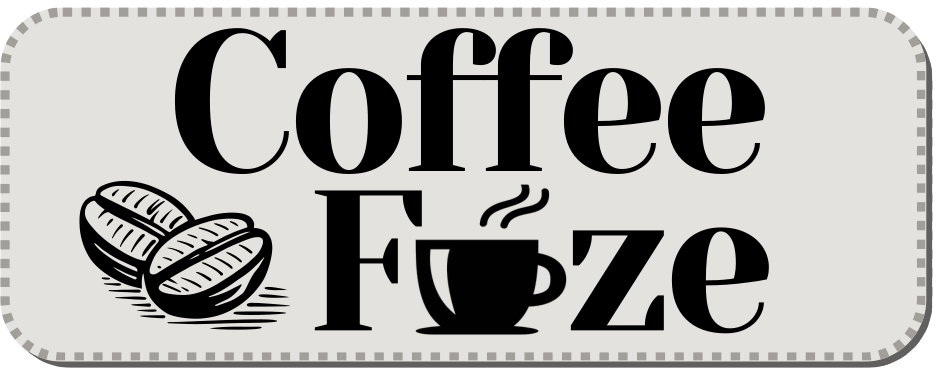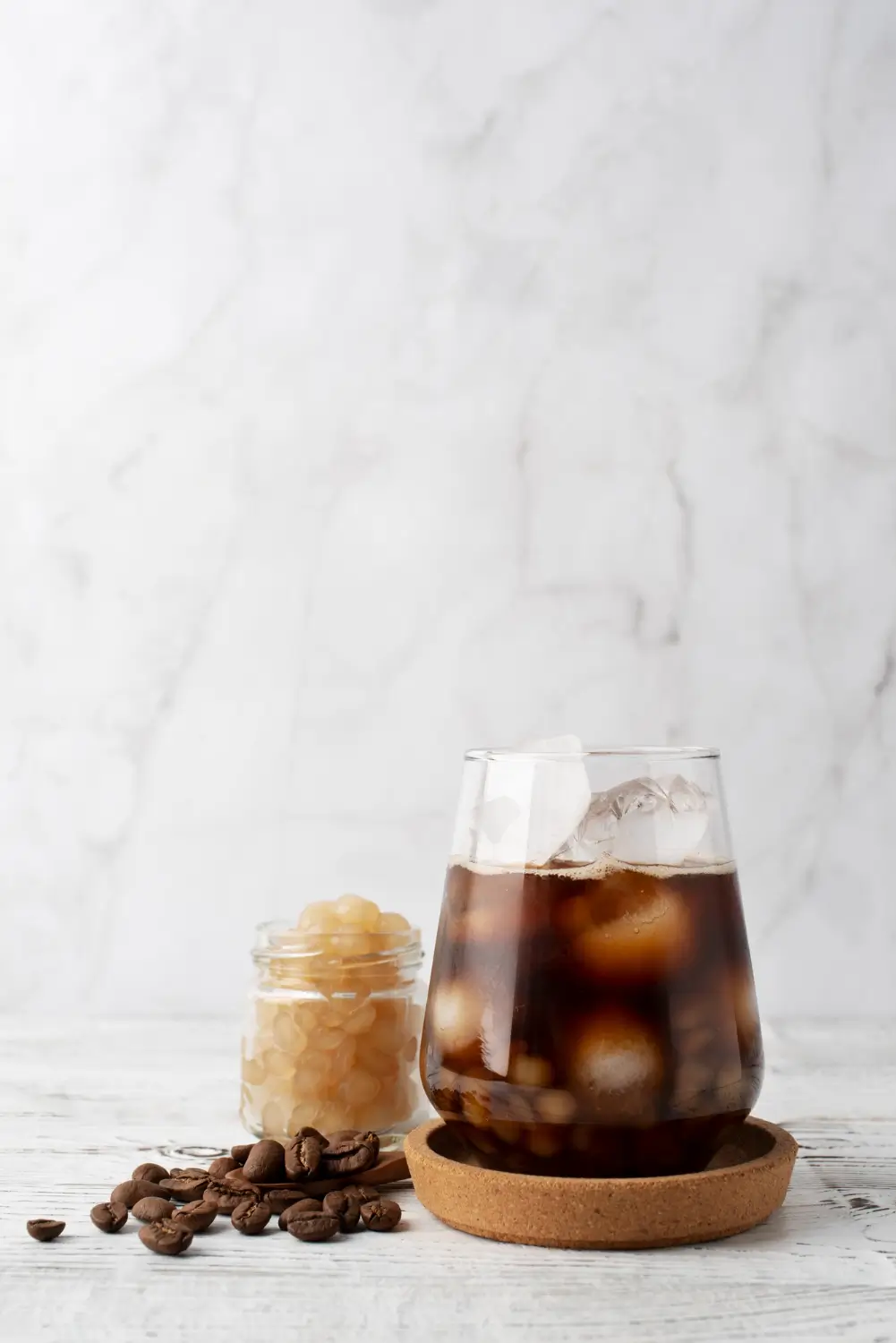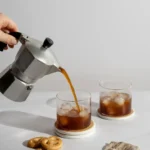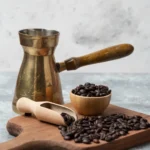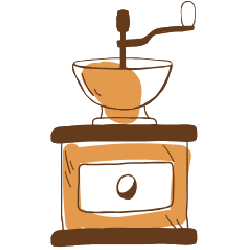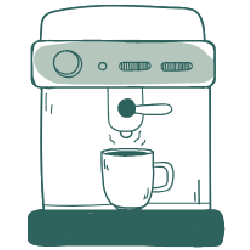Cold brew coffee has become a popular choice for many coffee drinkers. It offers a smoother, less acidic taste than traditional hot coffee. You make it by steeping coarse-ground coffee in cold water for a long time. People love cold brew for its versatility and naturally mellow flavor. It gives you a fresh coffee experience, whether you explore different types of coffee beans or various brewing methods.
What is cold brew coffee?
Cold brew coffee is a distinct type of coffee. You make it by steeping coarse-ground coffee beans in cold or room-temperature water for an extended period. This process usually lasts 12 to 24 hours. It uses low temperatures instead of heat to extract flavor. The method creates a potent coffee concentrate, not a ready-to-drink beverage.
This brewing technique gives cold brew its smoother, less acidic flavor. The Dutch first brought this method to Japan. There, it became known as “Dutch coffee” or “Kyoto-style” slow drip. This shows its long history in coffee culture. The slow, no-heat infusion method pulls different compounds from the coffee grounds.
How is cold brew coffee made using the traditional method?
Making cold brew coffee traditionally involves a few simple steps. These steps help you get its smooth flavor. You combine coarsely ground coffee with cold water. Let it steep for many hours. Then, you filter the liquid.
First, use a coarse coffee grind. This prevents over-extraction and makes filtering easier. Next, combine coffee grounds with cold or room-temperature water. A common ratio is 1:4 to 1:8—coffee to water by weight or volume. Let this mixture steep for 12 to 24 hours, either at room temperature or in a refrigerator.
After steeping, filter out the coffee grounds. You can use a paper filter, a fine metal sieve from a French press, or a specialized felt filter. These effectively separate the liquid from the solids. The final product is a strong cold brew concentrate. You must dilute it with water or milk before serving. This careful approach creates a rich, flavorful cold brew concentrate. It forms the base for many delicious coffee drinks, as our guide on how to make cold brew coffee at home explains.
How does cold brew coffee compare to hot brewed coffee in flavor and chemistry?
Cold brew coffee and hot brewed coffee differ in flavor and chemistry. Their brewing temperatures and extraction times create these differences. Hot brewing uses high temperatures to quickly extract compounds. Cold brewing relies on a long, low-temperature soak.
This core difference leads to variations in acidity, bitterness, sweetness, aroma, and mouthfeel. Knowing these distinctions helps you appreciate each brewing style.
What are the key flavor distinctions between cold brew coffee and hot brewed coffee?
The flavor differences between cold brew coffee and hot brewed coffee are clear. They come directly from how you brew them. These differences change everything from acidity to sweetness.
- Acidity: Cold brew coffee has much lower acidity, often up to 66% less than hot brewed coffee. This lower acidity creates a smoother, less sharp taste. It feels gentler on your stomach. Hot brew, on the other hand, has higher acidity.
- Bitterness: Cold brewing extracts fewer bitter compounds from the coffee grounds. This makes cold brew taste mellower and less bitter compared to hot brewed coffee.
- Sweetness: Cold brew coffee keeps more natural sugars, like sucrose. This makes it naturally sweeter. Cold temperatures limit the breakdown of these sugars, boosting its sweetness.
- Aroma/Volatile compounds: Hot brewed coffee has a richer, more complex aroma. This comes from extracting more volatile compounds like aldehydes, ketones, esters, pyrazines, and furans. These form during Maillard reactions and caramelization. Cold brew coffee has a milder, less aromatic profile because cold water extracts fewer of these compounds.
- Mouthfeel: Cold brew coffee usually feels smoother and rounder in your mouth. This sensation comes from extracting more lipids and oils during the long cold steeping. Hot brewed coffee often has a drier, crisper finish.
What are the chemical characteristics that distinguish cold brew coffee from hot brewed coffee?
The chemical makeup of cold brew coffee and hot brewed coffee explains their different flavors. The table below summarizes these key chemical variations.
| Characteristic | Cold Brew | Hot Brew |
|---|---|---|
| Extraction temperature | Cold temperatures (often room temp or fridge) | Near boiling water (around 90–96°C) |
| Extraction time | Long (6+ hours) | Short (minutes) |
| Acidity | Lower; fewer acidic compounds extracted | Higher extraction of organic acids |
| Bitterness | Lower; fewer bitter compounds extracted | Higher bitterness due to enhanced extraction |
| Volatile aromatic compounds | Fewer aldehydes, esters, pyrazines, furans; less aroma intensity | More volatile compounds from Maillard/caramelization reactions; more intense aroma |
| Sugar content | Preserved sugars (e.g., sucrose) lead to sweetness | Some sugars break down; balanced acidity and sweetness |
| Lipid/oil extraction | More lipids/oils extracted, contributing to smoothness | Lower lipid extraction |
As this comparison shows, the slower, colder extraction of cold brew coffee makes a drink that is sweeter, less acidic, and smoother. The fast, hot extraction of traditional coffee makes a more aromatic, acidic, and complex cup. Choosing between cold brew vs hot coffee depends on what you like.
What are the key differences between cold brew coffee and iced coffee?
The main differences between cold brew coffee and iced coffee are their brewing methods. This leads to distinct flavor profiles and caffeine content. Many people confuse these two cold coffee drinks, but they are quite different.
How do the brewing methods of cold brew coffee and iced coffee differ?
Brewing methods for cold brew coffee and iced coffee are very different. You make cold brew coffee through a cold-water immersion process only. No heat touches it during preparation. In contrast, iced coffee starts as hot brewed coffee. It uses methods like drip coffee, pour-over, or even espresso. You then chill it by pouring it over ice.
What are the flavor profile differences between cold brew coffee and iced coffee?
The flavor of cold brew coffee is smoother, mellower, and naturally sweeter. It has much lower acidity because of its cold extraction. Iced coffee keeps the brighter, often more pronounced, and acidic flavors from hot water extraction. So, iced coffee tastes like a cooled version of regular hot coffee. Cold brew offers a unique, gentler taste.
What are the caffeine content differences in cold brew coffee and iced coffee?
Cold brew concentrate usually has more caffeine per ounce. It often has about twice as much as regular coffee before you dilute it. Iced coffee, however, usually has less caffeine per ounce. The ice adds to its dilution, and its brewing process is much faster. If you want a stronger caffeine kick, you might prefer cold brew.
What are the serving and versatility aspects of cold brew coffee and iced coffee?
When you serve cold brew coffee, it is usually a strong concentrate. You need to dilute it with water or milk to reach your desired strength. Iced coffee is already brewed to strength. You simply cool it down and serve it over ice. Cold brew offers more versatility. You can gently heat it and enjoy it warm without bitterness. Iced coffee does not usually have this characteristic.
What are the health benefits and considerations of cold brew coffee?
Cold brew coffee offers several health benefits. It also has some important things to consider when you drink it. Its unique brewing method affects both its good health impacts and potential downsides.
What are the specific health benefits of cold brew coffee?
Cold brew coffee offers several health benefits. This makes it a good choice for many people. These advantages largely come from its unique brewing process and many good compounds.
- Less acidic and gentler on the stomach: Cold brew coffee has much less acidity than hot brewed coffee. This means it is less likely to cause digestive discomfort, like bloating or queasiness. This is especially true if you drink it on an empty stomach.
- Boosts metabolism: The caffeine in cold brew coffee can raise your metabolic rate by up to 11%. This helps burn fat and calories. It can support your weight management goals.
- May lower risk of chronic diseases: Drinking cold brew coffee regularly may lower your risk of various chronic conditions. These include type 2 diabetes, heart disease, certain cancers, Parkinson’s, and Alzheimer’s diseases.
- Rich in antioxidants: Cold brew coffee contains many antioxidants, like caffeoylquinic acid. These compounds help fight oxidative stress and inflammation in your body. This helps prevent disease.
- May improve mood and cognitive function: Just like hot coffee, the caffeine in cold brew coffee can improve your mood and overall cognitive function.
What are the important considerations and potential disadvantages of cold brew coffee?
Despite its benefits, cold brew coffee also has important points to consider and potential drawbacks. You should know these aspects to enjoy it safely and comfortably.
Its high caffeine content means cold brew coffee may cause jitteriness, anxiety, or a faster heart rate. This is especially true for people sensitive to caffeine or those with uncontrolled high blood pressure. Another concern is food safety risks. The long steeping time at low temperatures, usually 12–24 hours, can raise the risk of microbial contamination if you do not keep things clean during preparation. Even with lower acidity, cold brew coffee might still cause digestive issues for some people. This happens if they are very sensitive to coffee compounds, especially if they drink too much or on an empty stomach.
What are the best practices for brewing cold brew coffee?
Follow these best practices to get great results when you brew cold brew coffee. These techniques ensure a delicious, consistent outcome for your homemade batches.
Always use a coarse grind for your coffee beans. This helps proper extraction without too much bitterness. Next, combine your coffee and water. Steep the mixture for an optimal steeping time of 12 to 24 hours. Experiment to find the perfect duration for your taste. After brewing, store the finished cold brew in the refrigerator right away. This slows degradation and keeps its rich flavor. Dilute the cold brew concentrate with water or milk to your desired strength before serving. Adjust the dilution ratio to suit your preference.
How to serve and store your homemade cold brew coffee?
Serving and storing your homemade cold brew coffee correctly ensures maximum enjoyment and keeps its quality. These guidelines cover how to present your coffee best and extend its shelf life. They also keep food safety in mind.
How should you serve cold brew coffee for optimal enjoyment?
Serving cold brew coffee correctly improves its unique flavor and refreshing qualities. This means chilling it, diluting it, and adding flavors at the right time.
- Serve cold brew coffee chilled over ice for the most refreshing experience.
- Dilute the cold brew concentrate as needed. A common ratio is 1:3 concentrate to water or milk, based on your taste.
- Add flavors like sweeteners, milk, or creamer only when you serve it, not for storage. This keeps it fresh and prevents spoilage.
You can also gently heat cold brew coffee if you want a warm drink. It won’t develop the bitterness often linked with reheating regular coffee.
What is the optimal storage for cold brew coffee to maintain taste and shelf life?
Good cold brew storage practices are key to keeping its taste and extending its shelf life. Proper refrigeration and container choice really affect the coffee’s quality over time.
Always refrigerate cold brew coffee immediately after brewing. Colder temperatures slow down oxidation and keep its delicate flavor. Store the coffee in airtight containers, glass is best. This limits oxygen exposure and prevents it from picking up bad smells from the fridge. For the longest shelf life, keep the cold brew concentrate undiluted and free of additives. Diluted cold brew, especially with milk or creamer, spoils much faster.
Undiluted cold brew concentrate stays fresh in the fridge for 1–2 weeks. For longer keeping, you can freeze your concentrate in an airtight container. It can last for 2–3 months this way, though some flavor might change when thawed. Follow these guidelines to keep your cold brew delicious and safe to drink for a long time.
What are the cold brew storage guidelines?
Here are the main guidelines for storing your cold brew coffee. They help ensure great taste and longer life.
| Form | Fridge Shelf Life | Freezer Shelf Life | Notes |
|---|---|---|---|
| Undiluted concentrate | 1–2 weeks | 2–3 months | Store airtight, no additives |
| Diluted with additives | 2–3 days | Not recommended | Flavor degrades quickly |
For the best taste and shelf life, always store cold brew concentrate undiluted. Keep it in an airtight container in the fridge for up to two weeks. If you need longer storage, freezing the concentrate for up to several months is an option. Be aware that some flavor might change after thawing. Dilute and add flavors like milk or sweeteners only when you are ready to serve the coffee.
Cold brew coffee offers a unique and appealing experience for any coffee enthusiast. Its brewing process creates a smoother, less acidic, and naturally sweeter drink. This differs from traditional hot coffee or quickly chilled iced coffee. This makes it a great choice for those who want a gentler, more versatile coffee. It can also be good for your digestive health.
You have learned how to make cold brew at home, appreciate its many benefits, and master its storage. This guide covered all parts of this popular drink. Its easy preparation and pleasant flavor make cold brew coffee a regular part of modern coffee culture.
